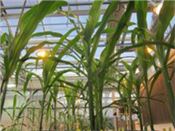Grant To Develop More Efficient Crops That Use Less Fertilizer, Produce Higher Yield

URBANA, ILL.
The Donald Danforth Plant Science Center announced it has received a three-year grant from the U.S. Department of Agriculture’s (USDA) National Institute of Food and Agriculture (NIFA) to enhance nitrogen use efficiency. The Center will collaborate with the University of Illinois on the $250,000 grant to identify genetic variants impacting photosynthesis and nitrogen uptake.
Genetic improvement of nitrogen use efficiency in crop plants will increase yield and reduce the demand for nitrogen-based fertilizer and energy inputs to produce the fertilizer, offering both economic and environmental benefits. Maize, also known as corn, is the world’s leading grain crop used primarily for animal feed, food and bioenergy. Currently, more nitrogen fertilizer is added to U.S. crop fields than plants can use. The excess nitrogen often ends up in waterways, ground water supplies and leads to algal blooms. In developing countries, the expense associated with nitrogen fertilizers limits many small shareholders’ access to improve their harvest.
“Understanding the mechanisms that underlie the efficient uptake and mobilization of nitrogen fertilizer in plants will enable plant breeders and researchers to develop more efficient crops that will use less fertilizer to produce more yield,” said Thomas Brutnell, Ph.D., director of the Enterprise Institute for Renewable Fuels at the Danforth Center. “This research will help us meet future global demands for food and energy while preserving the environment.”
“This work builds upon a long history of pioneering research by the University of Illinois on the genetics of nitrogen use in corn,” said Stephen Moose, U of I crop sciences professor. “We will now apply our recent discoveries to further optimize the important connections between photosynthesis and nitrogen in driving high corn yields.”
The project also utilizes the emerging technology, CRISPR/Cas9 to induce a very specific change in in the maize genome.
The new analytical techniques used in this research will support the tracking of movement of carbon and nitrogen through the plant, between cells and even within cells. The grant will help further support the understanding of nitrogen use efficiency and its impact on plant growth and development.
“Collectively, these tools will provide a level of understanding we have not been able to achieve before and greatly facilitate the translation of these findings to improve agriculture,” stated Brutnell. ∆